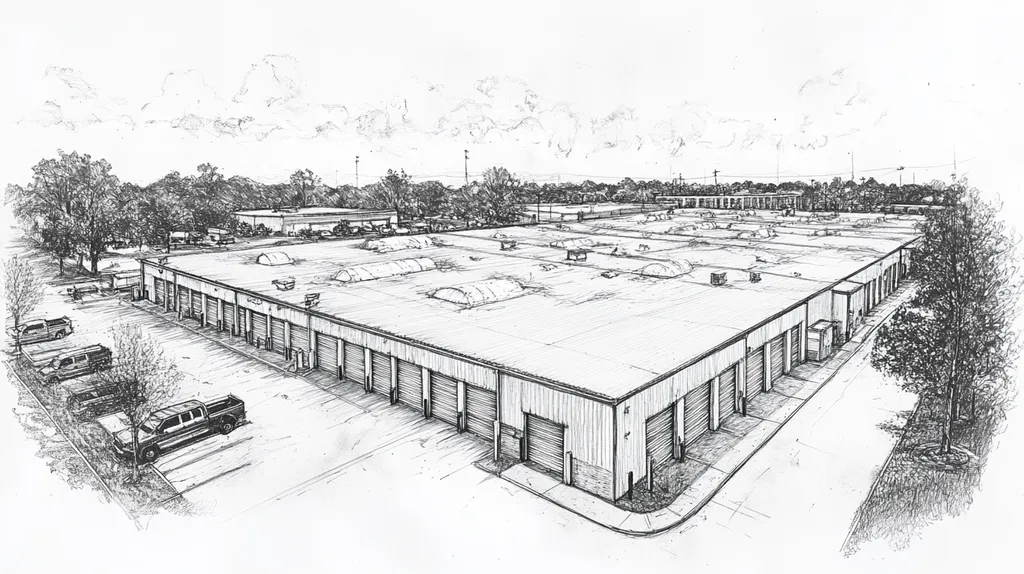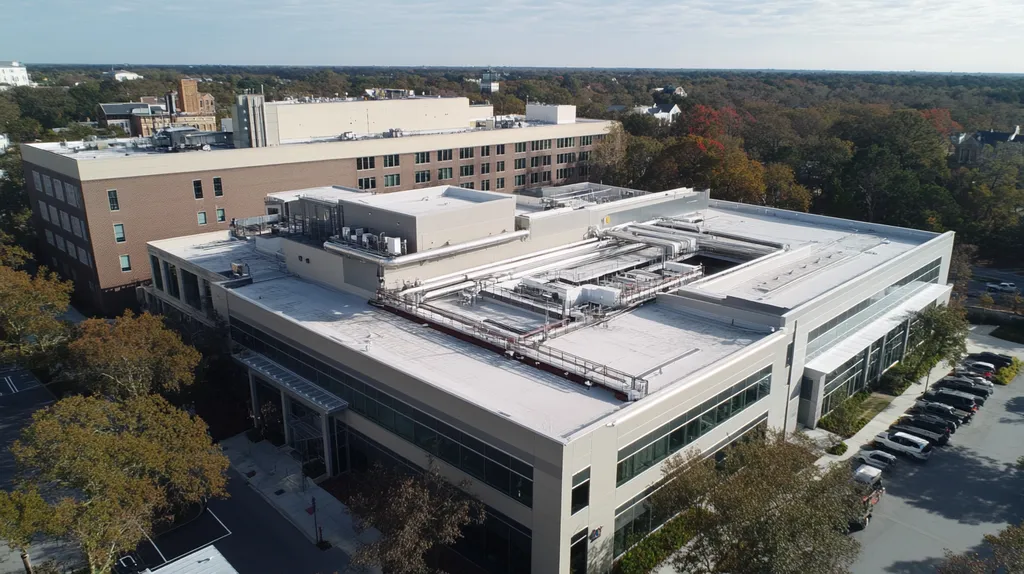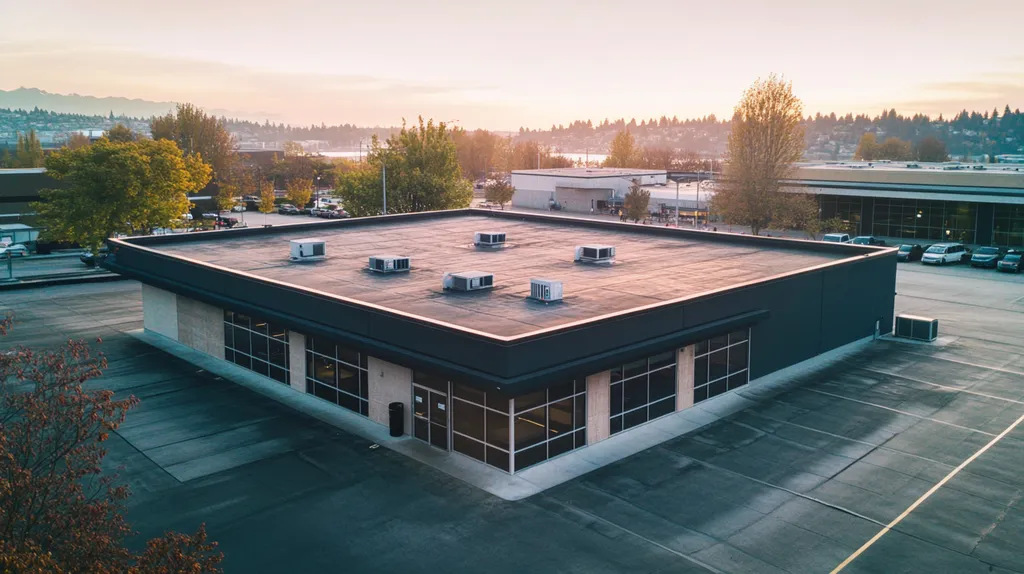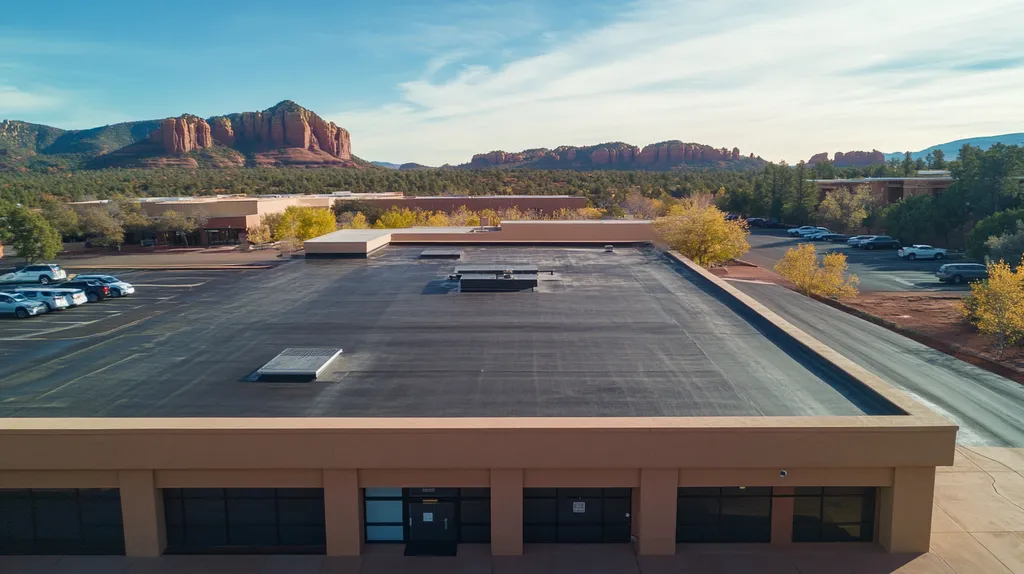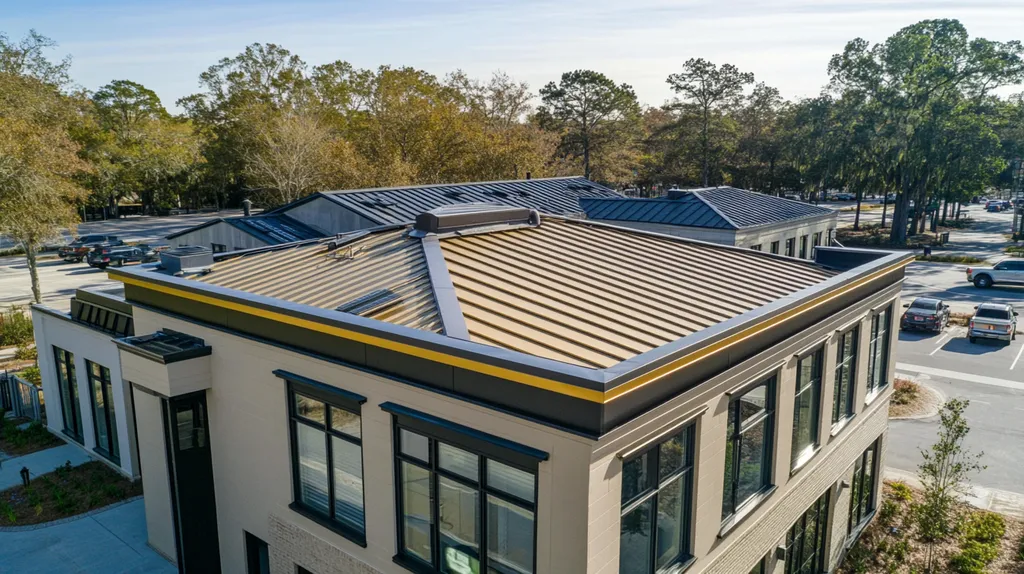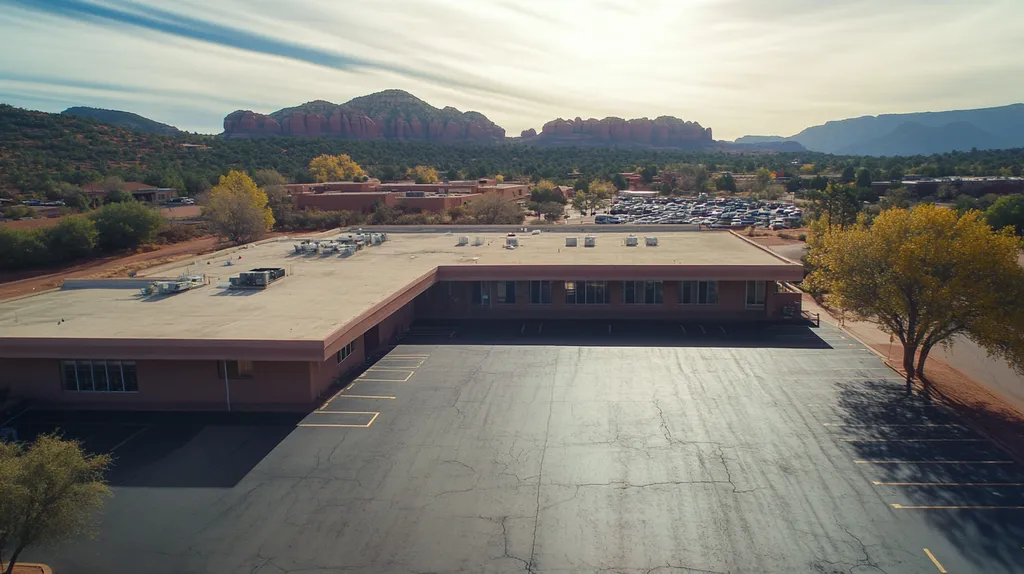In an era of rising energy costs and heightened environmental concerns, commercial property owners face mounting pressure to optimize their buildings’ efficiency. Studies show that effective awnings and overhangs can reduce cooling costs by up to 77% while extending roof lifespans by decades.
Yet many commercial buildings lack these critical sustainability features, leading to excessive energy consumption and premature roof deterioration. Understanding the strategic implementation of awnings and overhangs has become essential for property owners seeking to enhance their buildings’ performance.
This comprehensive guide examines how these architectural elements contribute to roof sustainability through improved energy efficiency, weather protection, and structural longevity.
SECTION 1: FUNDAMENTAL CONCEPTS
In an era marked by escalating energy costs and increased environmental scrutiny, understanding roof overhangs and awnings becomes paramount for enhancing commercial roof sustainability. As businesses strive to lower operational expenses and meet eco-friendly standards, incorporating overhangs can lead to substantial energy savings, protect facades from the elements, and extend the lifespan of roofing systems. This section delves into the definitions, types, and critical considerations associated with roof overhangs and awnings, equipping property owners with the knowledge needed to make sustainable design choices.
Definition and Purpose of Roof Overhangs
Roof overhangs are structural extensions that project beyond a building’s walls, designed primarily to offer shade and protection. These overhangs shield buildings from harsh rain, persistent snow, and harmful UV rays. By creating a barrier, they significantly reduce indoor heat gain during the warmer months, ultimately lessening the dependency on air conditioning systems.
Beyond temperature management, overhangs provide a critical defense against water intrusion. They ensure that precipitation doesn’t directly contact a building’s walls and foundation, which can lead to costly repairs and reduced structural integrity. By channeling rainwater away, property owners can also prevent mold growth and water damage, enhancing overall building health.
In urban environments, the benefits of overhangs extend to managing stormwater runoff. By catching and redirecting rainwater, they lessen the burden on city storm drains, contributing to more resilient urban infrastructure during heavy rain events.
Consequently, investing in roof overhangs is not just a matter of aesthetics; it’s a commitment to long-term savings and sustainability in modern commercial construction.
Types of Roof Overhangs and Their Benefits
Various types of roof overhangs exist, each engineered for specific climates and building designs, enhancing both functionality and comfort. One of the most common types is the fixed overhang, which provides year-round sun protection and plays a significant role in stabilizing indoor temperatures.
Adjustable overhangs present a flexible option. They allow property owners to modify shading according to seasonal changes. In winter, these overhangs can allow precious sunlight to warm interiors, while in summer, they provide essential shading to keep spaces cool, ultimately optimizing energy usage.
Retractable overhangs are particularly popular in commercial settings that incorporate outdoor spaces. These can be expanded or retracted based on needs, making them perfect for varying weather conditions and events. Their adaptability not only enhances comfort but can also yield significant energy savings.
Incorporating suitable types of overhangs not only curtails heating and cooling expenses but also enhances the visual appeal of a building. This added aesthetic benefit can improve marketability and overall property value.
Thus, selecting the right type of overhang requires thoughtful consideration of the building’s intended use and local climate to maximize its performance and benefits.
Climate and Architectural Considerations
Climate substantially influences the choice and effectiveness of roof overhangs and awnings. In regions with hot, sunny climates, wider overhangs are essential for providing shade, significantly lowering indoor temperatures. Conversely, in colder areas, more narrow overhangs allow sunlight to penetrate, which helps warm the interior during chillier months.
The architectural design of a building also impacts how well overhangs function. Factors such as the roof angle, building orientation, and surrounding landscape dynamics all play a role in determining optimal sunlight exposure and shadow patterns. A well-designed overhang can significantly augment natural ventilation, leading to a more comfortable indoor atmosphere.
Additionally, it is vital to consider local building codes, which may specify standards for overhangs regarding size, materials, and construction best practices. Awareness of these regulations is crucial for ensuring compliance and can influence choice decisions regarding sustainability.
By carefully evaluating climate and architectural features, property owners can make enlightened design choices that enhance energy efficiency and promote environmental sustainability.
SECTION 2: SYSTEM COMPONENTS
Awnings and overhangs may appear to be simple design features, but they are pivotal for improving the sustainability of commercial roofs. Insufficient structural support can lead to severe damage, resulting in costly repairs and wasted energy. Grasping the essential components—structural elements, material choices, and compatibility with various roofing styles—is crucial for establishing effective systems. This section explores these elements, illustrating their significance in creating sustainable roofing solutions.
Structural Elements: Rafters, Beams, and Soffits
The bedrock of any successful awning or overhang is built upon its structural components, such as rafters, beams, and soffits. These elements need to be sturdy enough to withstand adverse weather conditions, including strong winds, heavy snow, and relentless rain. For properties situated in areas with extreme weather, robust support structures are non-negotiable for maintaining roof strength.
Well-engineered rafters and beams deliver essential support, while soffits serve an important role in regulating airflow and minimizing moisture buildup. Unchecked moisture can lead to mold and wood decay, jeopardizing the longevity of both the awning and roofing systems. Careful planning in these areas can substantially curb long-term maintenance expenses.
Moreover, the alignment and connections of these elements must comply with local building codes and regulations. Adhering to these standards not only ensures safety but also enhances the overall sustainability of the roofing system. Consulting with qualified roofing professionals is advisable to guarantee proper integration of these vital components.
In summary, prioritizing sturdy structural elements is not just about safeguarding the roof; it also boosts the building’s energy efficiency, culminating in a more sustainable commercial property.
Material Selection: Durability and Maintenance
Choosing the right materials for awnings and overhangs is critical for fostering long-term sustainability. Commercial property owners should seek materials that can withstand the rigors of weather while minimizing upkeep. Popular options include aluminum, fiberglass, and treated wood, each with unique advantages.
For example, aluminum is lightweight yet remarkably durable, resisting rust and corrosion—making it particularly suitable for coastal regions where saltwater exposure is a concern. In contrast, treated wood offers an inviting aesthetic but typically requires more frequent maintenance to maintain its integrity.
Incorporating energy-efficient coatings or reflective materials can also mitigate heat absorption, enhancing roof performance and reducing the energy costs associated with heating and cooling. Property managers must carefully evaluate initial costs versus long-term benefits when selecting materials, to ensure sustainability is achieved across their investment.
In conclusion, strategic material selection significantly affects durability and maintenance, which directly influences the sustainability of the commercial roofing system.
Compatibility with Roofing Styles
The effectiveness of awnings and overhangs greatly depends on their compatibility with different roofing styles. Flat roofs require specific design strategies compared to sloped roofs. Recognizing these differences is essential to ensuring that these structures support rather than hinder the roof’s effectiveness.
For sloped roofs, overhangs effectively guide rainwater runoff, diminishing the risk of leaks. Conversely, flat roofs benefit from awnings that provide cooling shade, protecting membrane surfaces from solar degradation and heat accumulation. Understanding these distinctions is key to prolonging the life and function of the roof.
Additionally, ensuring that awnings and overhangs harmoniously integrate with existing roofing styles enhances property value. A cohesive design is not only visually appealing but also promotes energy efficiency and occupant comfort. Collaborating with roofing specialists can yield designs tailored to complement specific roofing systems effectively.
Ultimately, ensuring proper compatibility of awnings and overhangs with existing roofing styles maximizes sustainability, optimizing roof performance while extending its lifespan.
SECTION 3: IMPLEMENTATION METHODS
Implementing awnings and overhangs on commercial roofs is not merely a design choice; it represents a strategic move that can dramatically elevate sustainability efforts. With energy costs climbing and environmental accountability more important than ever, these features serve as effective tools for lowering heating and cooling demands, translating to significant operational savings. It’s essential for property owners and facility managers to grasp the intricacies of designing and executing these elements to enhance efficiency and prolong the lifespan of their roofs.
Designing for Energy Efficiency
The foundation of energy-efficient awning and overhang design lies in their strategic placement and material selection. By blocking direct sunlight during the sweltering summer months, these features help to significantly reduce reliance on air conditioning, and in the winter, they facilitate passive solar heating. This dual function not only promotes energy conservation but also optimizes indoor comfort.
Utilizing high-reflectivity materials for awning surfaces can further amplify energy savings by minimizing heat absorption, thereby keeping the building cooler. Additionally, incorporating energy-efficient LED lighting in these areas optimizes electricity use while enhancing visibility. For instance, studies show that awnings can reduce air conditioning use by up to 77% and lower electricity bills by as much as 26% (source: Retractable Awnings).
Local climate conditions should also inform design. Recognizing seasonal sun angles enables property owners to create tailored designs that enhance energy efficiency year-round. These thoughtful adjustments can lead to long-term cost benefits that make a tangible difference.
Lastly, employing energy modeling software during the design phase allows for a more accurate projection of energy savings, equipping facility managers with the necessary data to justify investments in sustainable roofing solutions.
Ensuring Proper Ventilation and Drainage
Proper ventilation and drainage are crucial for maximizing the effectiveness of awnings and overhangs. Without adequate airflow, moisture can accumulate and pose a serious threat to the roof’s integrity. Thoughtful design takes ventilation into account, helping to mitigate condensation risks and extend the roof’s lifespan.
Drainage is equally vital. Thoughtfully placed overhangs can effectively direct rainwater away from the building’s facade, preventing pooling and runoff issues. Integrating gutters and downspouts into the design facilitates better water management and helps maintain the building’s overall health.
Implementing a suitable slope on overhangs ensures efficient water drainage, reducing strain on roofing materials. Regular maintenance checks will keep these drainage systems clear and functioning effectively.
Incorporating ventilation panels into awning designs can also assist in allowing hot air to escape, promoting overall efficiency. This attention to detail ensures both durability and comfort for occupants, creating a beneficial outcome for everyone involved.
Customizing Overhangs for Specific Needs
Customization of awnings and overhangs is critical for addressing the distinct requirements of various buildings. For example, retail spaces might benefit from larger overhangs that offer shade for outdoor displays, enhancing customer experience. In contrast, office buildings may lean toward aesthetic design while still meeting functional needs.
Adjusting overhang depths and shapes can be tailored to amplify their impact based on the building’s architecture. Collaborating with a skilled designer ensures that aesthetic and practical considerations align seamlessly.
Compliance with local regulations and zoning laws must also be factored into customization efforts. Adhering to building codes upfront helps avoid costly retrofits down the line. Engaging with local authorities early in the planning stages can smooth this process.
Moreover, opting for sustainable materials such as recycled metals or rapidly renewable timber can bolster the environmental profile of awnings and overhangs. This strategy not only enhances the building’s sustainability efforts but also aligns it with broader ecological objectives.
SECTION 4: MAINTENANCE REQUIREMENTS
Maintaining awnings and overhangs is not just a good practice; it’s essential for maximizing the longevity and sustainability of commercial roofs. Neglecting regular maintenance can lead to costly repairs and significantly shorten the lifespan of roofing materials. Research indicates that effective maintenance can extend roof systems’ longevity by up to 50%. By understanding and prioritizing essential maintenance tasks, property owners can avoid unexpected issues and enhance the overall performance of their roofing systems.
Regular Inspection and Cleaning
Routine inspections are paramount for identifying potential problems before they escalate into costly repairs. Property owners should carry out these checks at least twice a year, paying close attention to the structural integrity of the awnings and overhangs. Look for early signs of wear, rust, or decay that could compromise these features.
Cleaning is of equal importance. Accumulated debris can trap moisture, creating ideal conditions for mold and mildew growth. Contaminants like leaves and dirt can also block drainage systems, resulting in water pooling and potential leaks.
Using a soft-bristle brush and gentle detergent can effectively clean surfaces without causing damage. For deeper cleaning, hiring professionals may be necessary to ensure thoroughness and prevent any lingering issues.
By scheduling regular inspection and cleaning, property managers can significantly reduce the risk of severe repairs, ensuring that awnings and overhangs consistently fulfill their protective roles for the underlying roof.
Protecting Against Pests and Weather Damage
Pests represent a serious threat to the integrity of awnings and overhangs, as they can cause structural damage and compromise functionality. Regular inspections should include checks for signs of pest infestations, such as nests or droppings.
Weather also takes a toll. Heavy winds and snowfall can loosen attachment points and warp materials. Moreover, winter storms can lead to ice buildup, creating additional weight and hazards.
To mitigate these risks, property owners should consider using pest-resistant materials and ensuring that effective drainage systems are in place. Sloped roofing can help direct water away efficiently, alleviating potential problems.
Proactively addressing the threats posed by pests and weather can help maintain the integrity of roofing systems, ultimately reducing the need for costly repairs or rebuilds.
Repair and Replacement Strategies
Recognizing when repairs are necessary is vital for maintaining the functionality of awnings and overhangs. Minor issues, such as small tears or cracks, can often be resolved with sealants or patches. Ignoring these minor repairs can lead to more significant damage over time.
In cases of severe damage, such as structural failure, replacement may be the most effective option. Understanding the specific materials and costs associated with replacing sections of the awnings is essential for proper budget planning.
Regular assessments can assist property owners in establishing a comprehensive repair schedule, ensuring that maintenance efforts align with annual budgets and operational needs. Adopting a proactive approach to repairs can also prevent emergencies that might disrupt business operations.
Ultimately, a well-planned strategy for repair and replacement not only extends the life of awnings and overhangs but also enhances the overall sustainability of commercial roofing systems, protecting valuable assets for years to come.
SECTION 5: PERFORMANCE METRICS
For commercial property owners, understanding the performance metrics of awnings and overhangs is essential to maximizing benefits. These structures play a significant role in energy efficiency and can lead to impressive cost savings. Research highlights their ability to reduce solar heat gain by up to 77%. This section investigates energy efficiency, weather protection, and the aesthetic and functional advantages that these roofing enhancements provide.
Energy Efficiency and Cost Savings
Awnings and overhangs offer remarkable improvements in energy efficiency. By shading windows and walls, they can dramatically decrease reliance on air conditioning systems, translating to significant cost reductions. Studies indicate that well-placed awnings can lower cooling costs by as much as 30%.
These features not only lessen energy expenses but may also allow properties to achieve energy efficiency certifications. Such credentials can elevate the market value of a building.
Furthermore, energy companies often provide rebates for energy-efficient installations, further mitigating initial investment costs. Incorporating awnings and overhangs into a commercial property aligns with ambitious sustainability goals and enhances efficiency in a competitive market.
In summary, integrating these structures is a strategic financial choice that allows businesses to thrive while contributing to environmental stewardship.
Protection Against Weather Elements
Awnings and overhangs serve as essential barriers against various weather conditions, thereby extending the lifespan of roofing materials. They protect against intense sunlight, rain, and wind, each of which hastens wear on roofing systems. Without them, roofs face significant risks from harmful UV exposure.
These enhancements also significantly reduce the chances of water intrusion, which can lead to mold, mildew, and compromised indoor air quality. Their protective layer is crucial for maintaining a healthier building environment.
Additionally, by diverting rainwater away from walls and foundations, overhangs prevent costly damages caused by moisture. This protective aspect is particularly crucial as extreme weather becomes more common.
Investing in awnings and overhangs is not merely advantageous; it is a forward-thinking solution for safeguarding property from unexpected repairs and financial strain.
Aesthetic and Functional Impact
Enhancing the visual appeal of a commercial property can significantly influence tenant interest and customer perception. Awnings and overhangs contribute to this appeal by adding texture and character, transforming ordinary entrances into inviting focal points.
Functionally, these structures create valuable outdoor spaces where customers can relax or businesses can showcase products, potentially increasing foot traffic and engagement.
Moreover, customizable designs enable businesses to reinforce brand visibility. Well-designed awnings serve not just as functional elements but also as extensions of a brand’s identity in crowded markets.
Ultimately, the aesthetic and functional benefits of awnings and overhangs significantly enhance a commercial property’s sustainability efforts, making them a wise investment for any savvy property owner.
SECTION 5: PERFORMANCE METRICS
For commercial property owners, grasping the performance metrics of awnings and overhangs is essential to unlock their full potential. These roofing enhancements not only improve energy efficiency but also lead to substantial savings. Research demonstrates that awnings can cut solar heat gain by as much as 77%, showcasing their significant impact. This section delves into energy efficiency, weather protection, and the aesthetic and functional advantages these features provide.
Energy Efficiency and Cost Savings
Awnings and overhangs greatly enhance energy efficiency. By shading windows and walls, they significantly decrease reliance on air conditioning, translating into impressive savings on energy bills. Studies reveal that carefully positioned awnings can lower cooling costs by up to 30%, an advantage not to be overlooked.
Moreover, these features can lead to energy efficiency certifications, enhancing a property’s market value. Not only do they slash operating expenses, but they also bolster a building’s sustainability profile.
Some utility companies even offer rebates for energy-efficient updates, further easing the initial investment. By integrating awnings and overhangs, property owners align their operations with broader sustainability goals, fostering efficiency in an increasingly competitive market.
In essence, incorporating these structures is a strategic financial move that allows businesses to thrive while championing environmental responsibility.
Protection Against Weather Elements
Awnings and overhangs are indispensable shields against harsh weather conditions, extending the lifespan of roofing materials. They guard against direct sunlight, rain, and wind, which can accelerate wear on roofs. Structures devoid of these features often suffer significant degradation from harmful UV exposure.
Furthermore, these enhancements effectively minimize water infiltration, averting serious problems like mold and mildew, which are detrimental to indoor air quality. Maintaining this protective barrier ensures a healthier building environment.
By directing rainwater away from walls and foundations, overhangs significantly reduce the risk of water damage. This proactive measure helps property owners steer clear of unexpected repair costs, which can strain budgets.
With extreme weather becoming commonplace, the importance of weather protection continues to rise. Investing in awnings and overhangs is not just sensible; it’s a proactive strategy to safeguard property from potential damage and financial strain.
Aesthetic and Functional Impact
The visual appeal of a commercial property significantly influences tenant interest and customer perceptions. Awnings and overhangs contribute to this aesthetic enhancement, adding texture and character that transforms ordinary entrances into inviting focal points.
Functionally, these structures create versatile outdoor spaces, inviting customers to relax or allowing businesses to showcase their products. This additional engagement can lead to increased foot traffic, enhancing overall customer interaction.
Moreover, the customization options available for awnings can boost brand visibility. These structures serve not only as functional elements but also as extensions of a brand’s identity, amplifying its presence in competitive markets.
In summary, the aesthetic and functional improvements provided by awnings and overhangs play a vital role in the sustainability strategy of any commercial property, marking them as essential investments for forward-thinking property owners.
Looking Ahead
As commercial buildings face mounting pressure to reduce their environmental impact, properly designed awnings and overhangs have emerged as critical sustainability solutions, offering energy savings of up to 77% while extending roof lifespans by decades.
These architectural elements represent more than aesthetic choices – they are essential tools in the fight against rising energy costs and premature roof deterioration.
The data is clear: buildings lacking these features consistently underperform in energy efficiency metrics and require more frequent roof maintenance and replacement.
For property owners seeking to maximize their building’s sustainability and value, implementing well-designed awnings and overhangs is no longer optional – it’s a strategic imperative that will define commercial roofing practices in the coming decades.
FREQUENTLY ASKED QUESTIONS
Q. What defines a commercial roof overhang?
A. Roof overhangs extend beyond a building’s walls, providing shade and weather protection, enhancing energy efficiency and prolonging the roof’s lifespan.
Q. How do structural elements impact my industrial roof?
A. Strong rafters and beams are crucial for supporting awnings and overhangs, reducing potential damage from adverse weather and promoting longevity of your roof.
Q. What design features enhance my commercial roof’s energy efficiency?
A. Awnings and overhangs should block summer sunlight for cooling, while facilitating passive solar heating in winter, optimizing energy use year-round.
Q. Why is maintenance critical for my commercial roof?
A. Regular inspections and cleaning prevent costly repairs and ensure the longevity of awnings and overhangs, keeping the roof’s protective functions intact.
Q. How much can awnings reduce my cooling costs?
A. Studies show awnings can lower cooling costs by up to 30%, improving energy efficiency and providing financial benefits through reduced utility bills.
Q. What should I consider when customizing overhangs?
A. Customization should reflect building needs, aesthetics, and local building codes, ensuring optimal performance while enhancing visual appeal and functionality.
Q. What are the environmental impacts of awnings and overhangs?
A. These structures help reduce energy consumption, minimize heat absorption, and prevent water damage, making them vital for sustainable commercial roofing solutions.

